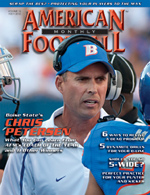AMERICAN FOOTBALL MONTHLY THE #1 RESOURCE FOR FOOTBALL COACHES
|
|
Article Categories
|
AFM’s College Coaches of the Yearby: David Purdum© More from this issueFCS
Andy Talley • Villanova
All season, Villanova kept tapping the rock, again, again and again, never knowing when it would break.
The rock was one of the founding blocks from the first church at Villanova, which was built in 1896. The square block sat in the Wildcats locker room and even traveled on the road. Before every practice and every game, players and coaches tapped the rock.
“This is what life is all about,” said Talley. “You’ve got to keep tapping the rock because you never know when you are going to have success.”
The ultimate success came in Talley’s 25th season at Villanova. The Wildcats went 14-1 and won their first FCS National Championship.
They did it behind a stiff run defense, a versatile running attack and by rarely t....The full article can only be seen by subscribers.
Subscribe today!

|
|
|
NOT A SUBSCRIBER?
Subscribe
now to start receiving our monthly magazine PLUS get INSTANT
unlimited access to over 4000 pages of 100 percent football coaching
information, ONLY available at AmericanFootballMonthly.com!
|
|
|
HOME
|
MAGAZINE
|
SUBSCRIBE
|
ONLINE COLUMNISTS
|
COACHING VIDEOS
|
Copyright 2025, AmericanFootballMonthly.com
All Rights Reserved






